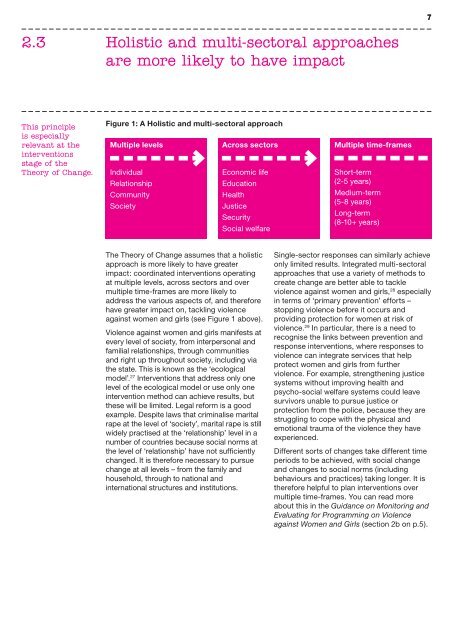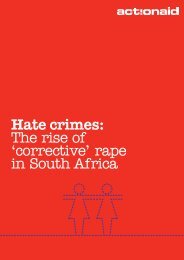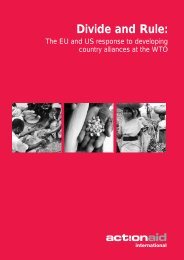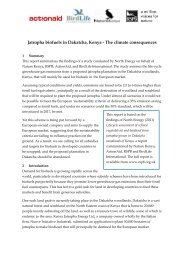62.2The state has primary responsibility<strong>for</strong> action on violence against womenand girlsThis principle isespecially relevantat the barriersand theinterventionsstages <strong>of</strong> the<strong>Theory</strong> <strong>of</strong> <strong>Change</strong>.The <strong>Theory</strong> <strong>of</strong> <strong>Change</strong> assumes that the statehas primary responsibility <strong>for</strong> action onviolence against women and girls: nationalgovernments are legally bound to, and holdthe ultimate responsibility <strong>for</strong>, theimplementation <strong>of</strong> laws, policies and servicesrelated to violence against women and girlsand can, and should be, held accountable <strong>for</strong>doing so. They are also well placed to achievechange on violence against women and girls.The obligation <strong>for</strong> states to prevent violenceagainst women and girls and to providecomprehensive services to survivors <strong>of</strong> suchviolence was established as a ‘due diligence’standard by General Recommendation No. 19<strong>of</strong> the UN Committee on the Elimination <strong>of</strong>Discrimination against Women in 1992. 15 TheRecommendation also stipulates the need <strong>for</strong>states to tackle the gender inequality that bothcauses and perpetuates violence againstwomen and girls.While there is still some work to be done(depending on the country) to re<strong>for</strong>m law andpolicy, in many contexts the normativeframeworks to address violence againstwomen and girls now exist. 16 The problem liesin the implementation <strong>of</strong> these frameworks. Inreality, no state in the world is effectivelyfulfilling its obligations to prevent violenceagainst women and girls, protect women andgirls from violence or provide comprehensiveservices to survivors. 17 The reasons <strong>for</strong> thisvary and include a lack <strong>of</strong> political will and lowinstitutional capacity at local, regional andnational levels. In some cases, conservativeideologies, such as so-called ‘religiousfundamentalisms’, 18 as well as entrenchedinstitutional sexism act as further barriers.Impunity is also a problem, particularly in thejustice and security sectors. For example,systematic failures <strong>of</strong> police, armies and lawen<strong>for</strong>cement agents at the local level putwomen and girls at risk <strong>of</strong> violence andprevent access to justice. 19 In extreme cases,failures <strong>of</strong> the state can manifest as stateviolence, where the state is the perpetrator <strong>of</strong>violence against women and girls. 20 In additionto being a violation <strong>of</strong> rights, this can lead towomen and girls avoiding or fearing agents <strong>of</strong>the state who are supposed to be acting astheir access point to claiming rights andjustice. This may especially be the case <strong>for</strong>certain groups <strong>of</strong> marginalised women such aswomen involved in the sex industry, lesbianwomen and migrant women. 21Lessons on working with the state to tackleimpunity and improve implementation <strong>of</strong> lawsand policy show targeted support can make asignificant difference. Through sector policydialogue and in joint sector reviews, missionsand sector consultative <strong>for</strong>ums, DFID and itspartners can influence national programmingon violence against women and girls andprovide appropriate, targeted capacity building<strong>of</strong> government institutions.For example, integrating violence againstwomen and girls programming in governanceand security sector re<strong>for</strong>m can build statecapacity to recognise, respond to and tackleviolence against women and girls. 22 Integratingviolence against women and girls programminginto education policy frameworks can help thestate to prevent, manage and work to eliminateviolence against girls in schools. 23 Integratingviolence against women and girls programminginto health systems strengthening can buildstate capacity to provide comprehensiveservices <strong>for</strong> survivors. 24 Integrating violenceagainst women and girls programming intohumanitarian and emergency response cansave lives and empower women to be part <strong>of</strong>ef<strong>for</strong>ts to rebuild their communities. 25Direct support to women’s rights organisations,<strong>for</strong> example through providing core, long-termfunding, can also support state ef<strong>for</strong>ts byensuring that civil society has the resources toshare its good practice with the state, raiseawareness <strong>of</strong> rights and services amongstwomen and girls and increase their access tojustice, and hold the state to account and helptackle impunity. 26 See the Practical Guide toCommunity Programming on <strong>Violence</strong> againstWomen and Girls <strong>for</strong> more detail.As discussed in further detail under Principle2.3, ef<strong>for</strong>ts to support holistic and multi-sectoralstate approaches to addressing violenceagainst women and girls, <strong>for</strong> example throughestablishing National Action Plans, areparticularly effective. DFID and its partners canadd value by promoting the participation <strong>of</strong>women’s rights organisations in the development,implementation and monitoring <strong>of</strong> such actionplans. It can also provide analytical andtechnical support to facilitate cross-departmentalworking, monitoring and evaluation.
72.3Holistic and multi-sectoral approachesare more likely to have impactThis principleis especiallyrelevant at theinterventionsstage <strong>of</strong> the<strong>Theory</strong> <strong>of</strong> <strong>Change</strong>.Figure 1: A Holistic and multi-sectoral approachMultiple levelsAcross sectorsIndividualEconomic lifeRelationshipEducationCommunityHealthSocietyJusticeSecuritySocial welfareMultiple time-framesShort-term(2-5 years)Medium-term(5-8 years)Long-term(8-10+ years)The <strong>Theory</strong> <strong>of</strong> <strong>Change</strong> assumes that a holisticapproach is more likely to have greaterimpact: coordinated interventions operatingat multiple levels, across sectors and overmultiple time-frames are more likely toaddress the various aspects <strong>of</strong>, and there<strong>for</strong>ehave greater impact on, tackling violenceagainst women and girls (see Figure 1 above).<strong>Violence</strong> against women and girls manifests atevery level <strong>of</strong> society, from interpersonal andfamilial relationships, through communitiesand right up throughout society, including viathe state. This is known as the ‘ecologicalmodel’. 27 Interventions that address only onelevel <strong>of</strong> the ecological model or use only oneintervention method can achieve results, butthese will be limited. Legal re<strong>for</strong>m is a goodexample. Despite laws that criminalise maritalrape at the level <strong>of</strong> ‘society’, marital rape is stillwidely practised at the ‘relationship’ level in anumber <strong>of</strong> countries because social norms atthe level <strong>of</strong> ‘relationship’ have not sufficientlychanged. It is there<strong>for</strong>e necessary to pursuechange at all levels – from the family andhousehold, through to national andinternational structures and institutions.Single-sector responses can similarly achieveonly limited results. Integrated multi-sectoralapproaches that use a variety <strong>of</strong> methods tocreate change are better able to tackleviolence against women and girls, 28 especiallyin terms <strong>of</strong> ‘primary prevention’ ef<strong>for</strong>ts –stopping violence be<strong>for</strong>e it occurs andproviding protection <strong>for</strong> women at risk <strong>of</strong>violence. 29 In particular, there is a need torecognise the links between prevention andresponse interventions, where responses toviolence can integrate services that helpprotect women and girls from furtherviolence. For example, strengthening justicesystems without improving health andpsycho-social welfare systems could leavesurvivors unable to pursue justice orprotection from the police, because they arestruggling to cope with the physical andemotional trauma <strong>of</strong> the violence they haveexperienced.Different sorts <strong>of</strong> changes take different timeperiods to be achieved, with social changeand changes to social norms (includingbehaviours and practices) taking longer. It isthere<strong>for</strong>e helpful to plan interventions overmultiple time-frames. You can read moreabout this in the Guidance on Monitoring andEvaluating <strong>for</strong> Programming on <strong>Violence</strong>against Women and Girls (section 2b on p.5).
















